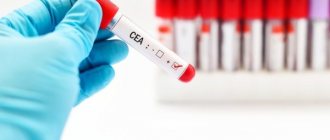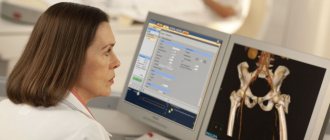Genetic typing of HLA B27 antigen
Genetic typing of HLA B27 antigen
- a genetic study for predisposition to the development of autoimmune diseases and the risk of developing ankylosing spondylitis and other associated seronegative spondyloarthropathies, during which the HLA-B27 allele of seronegative spondyloarthropathies is determined using PCR. A test for carriage of the histocompatibility antigen HLA-B27 (the susceptibility gene to ankylosing spondylitis) is an important argument in favor of the diagnosis of ankylosing spondylitis. It is believed that the appearance of HLA-B27 is possible in more than 90% of cases with ankylosing spondylitis and Reiter's syndrome (about 70%).
Ankylosing spondylitis (ankylosing spondylitis)
Ankylosing spondylitis (ankylosing spondylitis) is a chronic inflammatory disease of the spine and joints that leads to ankylosis (complete immobility of the joint). The reason is a genetic predisposition in people who are carriers of a certain antigen (HLA-B27).
Reiter's syndrome
Reiter's syndrome is a rheumatic disease that develops against the background of an infectious lesion of the intestines or genitourinary system and is manifested by inflammatory lesions of the genitourinary tract, joints and eyes: “urethritis-conjunctivitis-arthritis”. Occurs due to an autoimmune process as a result of a genitourinary or intestinal infection. The most common cause of the syndrome is chlamydia. Reiter's syndrome, which occurs after intestinal infections, is caused by Yersenia, Shigella, Salmonella or other intestinal pathogens.
Antigen HLA-B27
The product of the HLA-B27 gene - the HLA-B27 antigen - belongs to the molecules of the major histocompatibility complex of the first class, MHC-I (MHC-major histocompatibility complex), which are involved in the presentation of peptide antigens for their recognition by T lymphocytes. This is important for the formation of an immune response to foreign antigens. The set of HLA antigens is unique for each person. MHC class I genes are located in three loci (A, B and C) on the short arm of chromosome 6 and are characterized by a high degree of polymorphism. It has been established that genetic variations in the individual set of these antigens are associated with different susceptibility to various diseases.
There are 136 allelic variants known for the HLA-B gene. The frequency of locus B allele 27 (HLA-B27) varies depending on geographic region and ethnic group; HLA-B27 subtypes are also distinguished. Among Europeans, HLA-B27 occurs on average in 7–10% of the population. At the same time, it has been established that its incidence is much higher among patients with certain diseases. In 1973, the HLA-B27 gene was linked to ankylosing spondylitis. The presence of HLA-B27 in this disease is detected in almost 90% of patients. The likelihood of developing spondyloarthropathy in a person who is a carrier of HLA-B27 is tens of times higher than in a person without this gene (the risk of development in healthy individuals positive for HLA-B27 is about 2%).
Currently, a connection between this gene and other diseases has been established. The HLA-B27 antigen is detected in the majority of individuals with seronegative spondyloarthropathy.
Seronegative spondyloarthropathy
Seronegative spondyloarthropathy is a group of inflammatory rheumatic diseases. These include ankylosing spondylitis (Bechterew's disease), psoriatic arthritis, reactive arthritis, Reiter's syndrome, arthritis in inflammatory bowel diseases, recurrent uveitis, juvenile rheumatoid arthritis. The clinical symptoms of all these diseases include arthritis of the peripheral joints and joints of the axial skeleton; in addition, rheumatoid factor and other autoantibodies are usually not found in these diseases. It is the latter phenomenon that allows us to call them “seronegative”. The cumulative incidence of these diseases in the population is about 0.5%, which allows us to classify them as common autoimmune diseases.
The role of the HLA-B27 molecule in the pathogenesis of seronegative spondyloarthropathies has not been fully established. Among the hypotheses, the role of the architectonics of this molecule is discussed - the features of the conformational arrangement of the heavy chains of HLA-B27 molecules, the possible role of molecular “mimicry” of foreign antigens presented by HLA-B27 (a number of bacteria of the gastrointestinal or urogenital tract) and self-antigens. In particular, the role of Salmonella, Shigella, and Yersinia is confirmed as relevant infectious triggers of HLA-B27-dependent reactive arthritis.
Clinical suspicion of seronegative spondyloarthropathy in children and adults requires immunogenetic testing for the presence of the HLA B27 gene. This test is not a definitive study that allows you to accurately make a diagnosis or exclude it. However, given the low frequency of occurrence of HLA-B27 in the European population, its detection in a patient with clinical manifestations corresponding to this group of rheumatic diseases significantly increases the likelihood of this diagnosis.
Indications:
- differential diagnosis of early arthritis in children and adults;
- diagnosis of ankylosing spondylitis;
- diagnosis of psoriatic arthritis;
- diagnosis of reactive arthritis;
- diagnosis of Reiter's Syndrome;
- diagnosis of arthritis in inflammatory bowel diseases, recurrent uveitis, juvenile rheumatoid and psoriatic arthritis, ankylosing spondylitis.
Preparation
Genetic testing does not require special preparation. It is recommended to take blood no earlier than 4 hours after the last meal.
Before diagnosis, it is not recommended to expose yourself to stressful situations, drink alcohol or smoke.
Diet and medication intake do not affect the results of the study.
Interpretation of results
To interpret the results of genetic testing, consultation with a geneticist is required.
What is HLA?
Pass HLA at a discount in the online store
HLA - human leucocyte antigens - tissue compatibility antigens. (synonym: MHC - major histocompatibility complex - major histocompatibility complex).
On the surface of almost all cells in the body there are molecules (proteins) called major histocompatibility complex antigens (HLA antigens). The name HLA antigens was given due to the fact that these molecules are most fully represented on the surface of leukocytes (blood cells). Each person has an individual set of HLA antigens.
HLA molecules act as a kind of “antennas” on the surface of cells, allowing the body to recognize its own and foreign cells (bacteria, viruses, cancer cells, etc.) and, if necessary, trigger an immune response that ensures the production of specific antibodies and the removal of the foreign agent from the body.
The synthesis of HLA system proteins is determined by the genes of the major histocompatibility complex, which are located on the short arm of chromosome 6. There are two main classes of major histocompatibility complex genes:
- Class I includes genes of loci A, B, C;
- Class II - D-region (sublocuses DR, DP, DQ).
HLA class I antigens are present on the surface of almost all cells of the body, while class II histocompatibility proteins are expressed predominantly on cells of the immune system, macrophages, and epithelial cells.
Histocompatibility antigens are involved in the recognition of foreign tissue and the formation of an immune response. HLA phenotype is necessarily taken into account when selecting a donor for the transplantation procedure. The favorable prognosis for organ transplantation is higher when the donor and recipient are most similar in terms of histocompatibility antigens.
The relationship between HLA antigens and predisposition to a number of diseases has been proven. Thus, in almost 85% of patients with ankylosing spondylitis and Reiter's syndrome, HLA B27 antigen was detected. More than 95% of patients with insulin-dependent diabetes mellitus have HLA DR3, DR4 antigens.
When inheriting histocompatibility antigens, a child receives one gene of each locus from both parents, i.e. Half of the histocompatibility antigens are inherited from the mother and half from the father. Thus, the child is half foreign to the mother's body. This “foreignness” is a normal physiological phenomenon that triggers immunological reactions aimed at maintaining pregnancy. A clone of immune cells is formed that produces special “protective” (blocking) antibodies.
The incompatibility of spouses in terms of HLA antigens and the difference between the embryo and the mother’s body is an important point necessary for maintaining and carrying a pregnancy. During the normal development of pregnancy, “blocking” antibodies to paternal antigens appear from the earliest stages of pregnancy. Moreover, the earliest are antibodies to histocompatibility class II antigens.
The similarity of spouses in terms of histocompatibility antigens leads to the “similarity” of the embryo to the mother’s body, which causes insufficient antigenic stimulation of the woman’s immune system, and the reactions necessary to maintain pregnancy are not triggered. Pregnancy is perceived as foreign cells. In this case, spontaneous abortion occurs.
To determine histocompatibility antigens, HLA typing is performed in spouses. To carry out the analysis, blood is taken from a vein, and leukocytes (blood cells on the surface of which histocompatibility antigens are most widely represented) are isolated from the resulting sample. The HLA phenotype is determined by the polymerase chain reaction method.
The Center for Immunology and Reproduction recommends determining the HLA phenotype for married couples with infertility and miscarriage, unsuccessful IVF attempts, as well as spouses who are related.
Tags: immunology of reproduction
Typing of a married couple for three HLA class II genes with commentary (2 people) DQA1, DQB1, DRB1
One of the pressing issues in gynecology is the problem of miscarriage and the impossibility of conception. Quite often, seemingly healthy young spouses cannot have children. One of the reasons causing these problems may be the close affinity of the spouses according to the HLA antigen system. Each person has his own personal set of HLA antigens. By inheriting histocompatibility antigens, the fetus receives one gene for each locus from the mother and father. To carry a child and give birth to a genetically healthy organism, the antigens of the father and mother must be different. The child, as a result of the union of parental germ cells, has its own, strictly specific antigens, “foreign” to the mother’s immunity. At the same time, the mother’s body reacts to the new cells of the child by turning on special mechanisms that protect the fetus: protective antibodies are synthesized that suppress the rejection process. If this does not happen, it leads to termination of pregnancy. If the antigens of the father and mother are the same, then the child will be a carrier of antigens identical to the mother’s. The female body considers the cells of the embryo to be its own, which means it does not trigger protective mechanisms to preserve the fetus, which leads to miscarriage. The histocompatibility complex affects not only the fertilization process itself, but also the attachment of the embryo and the gestation of the fetus. A dependence has been noticed: the more alleles of HLA genes are similar in spouses, the higher the risk of miscarriage. About 35% of couples with repeated miscarriages have 2-3 matches. If four or more similar alleles are found, then miscarriage and unsuccessful IVF attempts will occur in almost all cases. HLA – human leukocyte antigen, major histocompatibility complex. It is a system of genes and corresponding human histocompatibility antigens. Represented by more than 150 antigens. They are located on the short arm of chromosome 6. HLA2 class typing is a study of the antigenic structure of a molecule in relation to certain groups of antigens. The most widely used in clinical practice is the determination of 3 HLA class II genes: DRB1, DQA1 and DQB1. The role of HLA class 2 is important in the development of the acquired immune response to antigens of foreign proteins, thereby ensuring human resistance to infections. At the same time, HLA class 2 is the cause of the onset of autoimmune diseases, such as type I diabetes mellitus, rheumatoid diseases, and autoimmune thyroiditis. HLA2 class typing is an extremely important test for selecting a transplant and hematopoietic stem cells (bone marrow). Molecular genetic HLA typing is carried out using polymerase chain reaction in real time.
Indications for HLA typing (spousal compatibility):
- Infertility of married couples
- History of miscarriage
- Before the IVF procedure
- For preventive purposes, examinations must be completed for a man and a woman (married couple) who want to have children.
general characteristics
HLA-B27 is one of the most studied antigens, and identification of its carriage is of great importance in early diagnosis and choice of treatment tactics for a number of autoimmune diseases. The HLA-B27 antigen is a molecule of the major histocompatibility complex of the 1st class - MHC-I (MHC-major histocompatibility complex), located on the short arm of chromosome 6 and encoding the molecular structures of the HLA system (human leukocyte antigens). The HLA-B27 antigen is detected in rheumatoid arthritis, psoriatic arthritis, chronic inflammatory bowel diseases occurring with sacroiliitis and spondylitis, uveitis and reactive arthritis of infectious origin. Klebsiella pneumoniae, Salmonella, Yersinia, Shigella, Chlamidia trachomatis are suspected as infectious triggers. The detection of the HLA-B27 antigen is also associated with a group of diseases that affect not only peripheral joints, but also the sacroiliac joints and the spine, such as ankylosing spondylitis. These diseases are often accompanied by the development of serious complications in the form of peripheral arthritis, ophthalmopathies, lesions of the genitourinary tract, intestines and skin. According to modern concepts, the role of the HLA-B27 antigen is to present an arthritogenic peptide to T cells, which causes an autoimmune response directed against the body’s own tissues.
Determination of allele 27 of locus B (HLA B 27)
Spondyloarthritis is a group of inflammatory diseases of the axial skeleton that have a pronounced genetic orientation. These include ankylosing spondylitis (Bechterew's disease), reactive arthritis (Reiter's syndrome), psoriatic arthropathy and some other diseases. Most patients with spondyloarthritis are carriers of a certain allele of the B locus of the human major histocompatibility complex - HLA-B27. For screening, diagnosis, and prognosis of spondyloarthritis, a genetic study (typing) is performed to identify the presence or absence of the HLA-B27 allele. About 8% of people are carriers of the HLA-B27 allele (HLA-B27-positive; in the literature you can also find the expression “carriers of the HLA-B27 antigen”). The prevalence of ankylosing spondylitis in HLA-B27-positive people is 1.3%. It occurs in 15-20% of HLA-B27-positive patients who have a blood relative with ankylosing spondylitis, which corresponds to a 16-fold increase in the risk of this disease in the presence of a family history. A positive HLA-B27 typing result increases the risk of developing any disease from the group of spondyloarthritis by 20 times. Therefore, HLA-B27 typing can be used to assess the risk of developing spondyloarthritis. In the differential diagnosis of articular syndrome, the presence of HLA-B27 is a characteristic feature of spondyloarthritis: this allele is present in 90-95% of patients with ankylosing spondylitis, in 60-90% - with reactive arthritis, in 50% - with psoriatic arthropathy and 80-90% - with juvenile ankylosing spondylitis. The presence of HLA-B27 in patients with other diseases affecting the joints (gout, rheumatoid arthritis, septic arthritis) does not exceed 7-8%. HLA-B27 typing is particularly useful when the diagnosis of a disease cannot be formulated based on basic diagnostic criteria. HLA-B27 typing is of greatest importance in the diagnosis of early ankylosing spondylitis. In most cases, 5-10 years pass between the appearance of the first signs of the disease and the final diagnosis. This is due to the fact that the main diagnostic criterion is radiological signs of sacroiliitis, which develops only after several years of inflammation in the sacroiliac joints. Patients with complaints of back pain without radiological signs of sacroiliitis actually do not come to the attention of a rheumatologist. Detection of HLA-B27 in such a situation may be sufficient grounds for referral to a specialist. Typing is indicated when examining a patient with complaints of inflammatory pain in the back in the absence of radiological signs of sacroiliitis or when examining a patient with asymmetric oligoarthritis. The presence of HLA-B27 is associated with an increased risk of extra-articular manifestations of ankylosing spondylitis. The most significant associations are between the HLA-B27 allele and acute anterior uveitis, aortic valve insufficiency, acute leukemia, IgA nephropathy and psoriasis. HLA-B27-positive patients are at higher risk of tuberculosis and malaria. On the other hand, the presence of HLA-B27 also plays a certain “protective” role: some viral infections (influenza, herpes virus infection type 2, infectious mononucleosis, hepatitis C and HIV) occur in a milder form in HLA-B27 carriers. It should be noted that there are other, both hereditary and acquired, risk factors for the development of spondyloarthritis. The absence of HLA-B27 does not contradict the diagnosis of ankylosing spondylitis, in which case it is classified as HLA-B27-negative and develops at a later age than HLA-B27-positive spondylitis. In addition, HLA-B27 typing is used to predict complications of rheumatoid arthritis. The presence of HLA-B27 is associated with a threefold increase in the risk of atlantoaxial subluxation. What is the analysis used for:
- For differential diagnosis of articular syndrome (seronegative spondyloarthritis, rheumatoid and septic arthritis, gout and others).
- For screening, diagnosis and prognosis of ankylosing spondylitis.
- To assess the risk of developing atlantoaxial subluxation in rheumatoid arthritis.
When is the analysis prescribed: For articular syndrome: asymmetric oligoarthritis, especially in combination with pain in the lumbar region of the back of an inflammatory nature (morning stiffness for more than 1 hour, improvement with physical activity, worsening at night) and signs of enthesitis. With a family history of ankylosing spondylitis. For rheumatoid arthritis. What do the results mean: Reference values: negative. Positive result:
- occurs in 90-95% of patients with ankylosing spondylitis and juvenile ankylosing spondylitis,
- in 60-90% of patients with reactive arthritis,
- in 50% with psoriatic arthropathy,
- in 7-8% of people in the European population.
Negative result:
- observed in 92-93% of people in the European population,
- in 10% of patients with ankylosing spondylitis (HLA-B27-negative spondylitis).
What can influence the result: Hemolysis of lymphocytes in a blood sample leads to a false negative result.
References
- Khamaganova E.G. HLA-A*/B*C*/DRB1*/DQB1* genes and haplotypes in bone marrow donors from the registry of the Federal State Budgetary Institution “Hematology Research Center” of the Ministry of Health of Russia, who self-identified as Russian. // Khamaganova E.G., Kuzminova E.P., Chapova R.S., Gaponova T.V., Savchenko V.G. – Hematology and Transfusiology, 2021 No. 2. P.65-70.
- Batdyeva A.Kh. The importance of HLA system genes in predicting multifactorial diseases.// Batdyeva A.Kh., Popov A.A. – Bulletin of medical Internet conferences, 2021. No. 6. P. 1069.
- J. Street, J. Johnson, A. J. Lemin, C. Harvey, C. Darke. Immunogenetics of three novel HLA-Class II alleles: DRB1*03:112, DQB1*03:02:16 and DQB1*03:139. – International journal of immunogenetics, 2021. Feb;43(1):40-4. Doi: 10.1111/iji.12244.
Description
Study of venous blood to identify predisposition to inflammatory diseases affecting the joints and spine.
During the study, the HLA-B27 antigen is determined using flow cytometry.
The HLA-B27 antigen is a specific protein found on the surface of immune cells. It belongs to the proteins of the human major histocompatibility complex, which mediates various immune responses.
The HLA-B27 antigen is detected in the majority of individuals with seronegative spondyloarthropathy. This is a heterogeneous group of diseases, which includes: ankylosing spondylitis (ankylosing spondylitis), psoriatic arthritis, reactive arthritis, Reiter's syndrome, arthritis in inflammatory bowel diseases, recurrent uveitis, juvenile rheumatoid arthritis. The clinical symptoms of all these diseases include arthritis of the peripheral joints and joints of the axial skeleton; in addition, rheumatoid factor and other autoantibodies are usually not found in these diseases. It is the latter phenomenon that allows us to call them “seronegative”. The cumulative incidence of these diseases in the population is about 0.5%, which allows us to classify them as common autoimmune diseases.
The product of the HLA-B27 gene - the HLA-B27 antigen - belongs to the molecules of the major histocompatibility complex of the first class, MHC-I (MHC-major histocompatibility complex), which are involved in the presentation of peptide antigens for their recognition by T lymphocytes. This is important for the formation of an immune response to foreign antigens. The set of HLA antigens is unique for each person. MHC class I genes are located in three loci (A, B and C) on the short arm of chromosome 6 and are characterized by a high degree of polymorphism. It has been established that genetic variations in the individual set of these antigens are associated with different susceptibility to various diseases.
There are 136 allelic variants known for the HLA-B gene. The frequency of locus B allele 27 (HLA-B27) varies depending on geographic region and ethnic group; HLA-B27 subtypes are also distinguished. Among Europeans, HLA-B27 occurs on average in 7-10% of the population. At the same time, it has been established that its occurrence is significantly higher among patients with certain diseases; in 1973, a connection was established between the HLA-B27 gene and ankylosing spondylitis. The presence of HLA-B27 in this disease is detected in almost 90% of patients. The likelihood of developing spondyloarthropathy in a person who is a carrier of HLA-B27 is tens of times higher than in a person without this gene (the risk of development in healthy individuals positive for HLA-B27 is about 2%).
Despite the presence of a persistent association of the HLA-B27 antigen and the risk of developing spondyloarthritis, a positive test result does not always reflect the real risk of the disease in a particular patient and is not a definitive test that allows one to accurately make a diagnosis or exclude it. This is due to the fact that the HLA-B27 antigen is represented by 49 different variants, characterized by varying degrees of association with this group of diseases. Thus, the HLA-B2708 variant has the greatest association with the disease, while the HLA-B2706 and HLA-B2709 variants do not appear to be associated with disease risk at all. However, given the low frequency of occurrence of HLA-B27 in the European population, its detection in a patient with clinical manifestations corresponding to this group of rheumatic diseases significantly increases the likelihood of this diagnosis. Additional information about the patient's genetic background may help in interpreting a positive result.
There are other, both hereditary and acquired, risk factors for the development of seronegative spondyloarthritis. The absence of HLA-B27 does not contradict the diagnosis of ankylosing spondylitis. Ankylosing spondylitis is then classified as HLAB27 negative.








